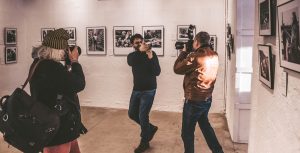1) Curate your artists.
Once the topic is decided, you will want to begin searching for artists’ who are aligned with your theme. Social networking platforms such as Facebook, Twitter and Instagram excellent tools for cultivating relationships with other artists. There are also websites out there specifically for networking within the art world. When reaching out, explain in detail your vision and where they fit in context. You will want to tell them all about your event’s strategies and logistics.
2) Locate a location/venue.
The location could be in a venue or a public park, but it has to be in a space that enhances the art. You do not need to drain yourself financially to put on a good show, formal galleries are a path but not the only one. What is crucial is that the distance is spacious, secure, and accessible. Everything you are going to want to do is consider the overall design of your display and the circumstance where you desire the artworks to noticed. Consider how you’re going to be able to space out the bits, and the way you want audiences to maneuvre about the display. Make sure you communicate transparently with all the site’s legal owner and down something in writing.
3) Ascertain the price.
If you have opted to pay for a location, you will need to pay for some basic costs and catering. The range of individuals you are expecting and also the degree of setup needed will normally determine the expense of your exhibition. Larger shows in larger places often come with larger bills. In the event the sum to lease a space is tight, then you might need to contemplate setting up and taking down a display at precisely the exact same moment. You may even need to get insurance.
4) If necessary, figure outside financing.
The Australian Government has funding available that you can apply for. Occasionally your site will host your display at no cost, and sometimes it’s possible to make a deal to get a proportion of the works offered. Some artists and curators raise cash through budding websites like Pozible or even GoFundMe.

5) Setup is everything.
As a curator, you will need to organise and oversee the transportation of event equipment and furniture, with a common example being tables and chairs. Asset management software allows you to closely monitor these deliveries. Attempt to give yourself ample time to experimentation and make things presentable until the show opens. Contemplate foot traffic and in which large volumes of it is going to be located. On this issue of foot traffic, make sure that most musicians are correctly and clearly credited for their participation. Moreover, be conscious of lighting. Excessively dark or overly bright functions can be distracting, but everything could function if the circumstance is appropriate. It is important you manage your time appropriately, considering using a mobile management system to stay on track.
6) Getting people to attend.
Social media is your best friend in this day and age. Use Facebook and Instagram to your advantage. Encourage your friends to use word of mouth and have them share the event online on their private social accounts. This is a great form of free advertising. Create a media package that sells the event and makes people want to come. Give it character, make it aesthetic, these factors make all the difference. Flyers are essential in the art world, be prepared.
7) The launching.
The key to controlling your environment is preparation. You never know who will rock up, or how many, or if their behavior will be antisocial. Ensure all your logistics are in check and first aid supplies on hand. Finally, have fun and faith in your art!
